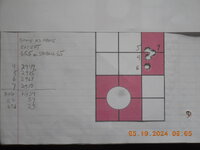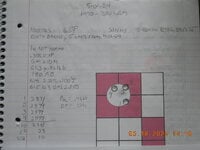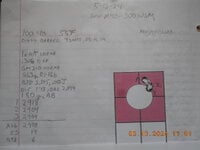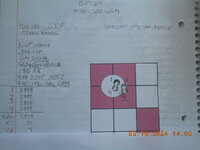I had a Douglas xx barrel installed on a LH M70 300 WSM. Some early results with old brass and 180 gr. BT bullets were posted earlier: https://forum.nosler.com/threads/300-wsm-180-bt-rl-16.46863/. Those results were very encouraging.
I went on to neck turn some new Norma brass, and fire form them to my minimum spec. chamber. During the fireforming, I confirmed that the loads with the new brass did not reproduce the results I had with the other older multiple fired brass. No surprise there. However, I did have some very encouraging groups with RL-16 and 180 gr. BT bullets, RL-16 and 180 gr. AB bullets, and StaBALL 6.5 and Sierra SBT bullets. Here is an example with StaBALL 6.5 and 180 gr. Sierra SBT:

In the above group I was using some VERY OLD CCI 250 primers that had been given to me. Looking at the extreme spread, I think it might have been even better with a different primer.
In general, I found that Nosler BT bullets seemed to like a jump of about 0.050" and the Sierra SBT bullets seemed to like jumps of about 0.030".
Once I had fired 50 pieces of neck turned brass, I annealed the cases using the molten lead method, bumped the shoulders back about 0.001" - 0.002". Sizing the annealed brass produced more consistent results than I ever had resizing before.
Then I switched back to Reloder 16 (of which I have a good supply) and changed up to my preferred elk bullet, the 180 gr. AB.
While reloading for other rifles, I had found that some of them liked a bullet jump of about 0.100" with the AB bullet.
I had some decent results when I shot a ladder test in 0.3 gr. powder increments with a 0.100" bullet jump. My best group was with 61.3 gr. RL-16.

I shot groups with a 0.090" jump and a 0.110" jump, and the group sizes both measured greater than 1". Thinking, I could improve on that I shots groups with bullet jumps of 0.050", 0.060", 0.070", and 0.080". A bit to my surprise my best results were with a 0.050" jump - similar to what the 180 gr. BT seemed to like in this rifle.

That target was the first shots though a dirty barrel that had been sitting for a week. I was pleased to see the first "cold barrel" shot was in the group.
I cleaned the rifle and loaded four more rounds. However, since the lot of Reloder 16 I had been using was running low, I switched to a different lot of powder. Then I shot this target through a clean bore.

I was pleased that the first shot though the clean barrel was "in the group".
I am happy with that. After I use the last of six once-fired brass to zero at 200 yards, I will have only enough AB bullets (of the same lot) and powder (of the same lot) left to load up 40-50 rounds. So, I am calling load development good enough. I will anneal, size, and brass prep the 50 cases and load for hunting.
I am happy with the relatively low velocity of this load for three reasons:
I went on to neck turn some new Norma brass, and fire form them to my minimum spec. chamber. During the fireforming, I confirmed that the loads with the new brass did not reproduce the results I had with the other older multiple fired brass. No surprise there. However, I did have some very encouraging groups with RL-16 and 180 gr. BT bullets, RL-16 and 180 gr. AB bullets, and StaBALL 6.5 and Sierra SBT bullets. Here is an example with StaBALL 6.5 and 180 gr. Sierra SBT:

In the above group I was using some VERY OLD CCI 250 primers that had been given to me. Looking at the extreme spread, I think it might have been even better with a different primer.
In general, I found that Nosler BT bullets seemed to like a jump of about 0.050" and the Sierra SBT bullets seemed to like jumps of about 0.030".
Once I had fired 50 pieces of neck turned brass, I annealed the cases using the molten lead method, bumped the shoulders back about 0.001" - 0.002". Sizing the annealed brass produced more consistent results than I ever had resizing before.
Then I switched back to Reloder 16 (of which I have a good supply) and changed up to my preferred elk bullet, the 180 gr. AB.
While reloading for other rifles, I had found that some of them liked a bullet jump of about 0.100" with the AB bullet.
I had some decent results when I shot a ladder test in 0.3 gr. powder increments with a 0.100" bullet jump. My best group was with 61.3 gr. RL-16.

I shot groups with a 0.090" jump and a 0.110" jump, and the group sizes both measured greater than 1". Thinking, I could improve on that I shots groups with bullet jumps of 0.050", 0.060", 0.070", and 0.080". A bit to my surprise my best results were with a 0.050" jump - similar to what the 180 gr. BT seemed to like in this rifle.

That target was the first shots though a dirty barrel that had been sitting for a week. I was pleased to see the first "cold barrel" shot was in the group.
I cleaned the rifle and loaded four more rounds. However, since the lot of Reloder 16 I had been using was running low, I switched to a different lot of powder. Then I shot this target through a clean bore.

I was pleased that the first shot though the clean barrel was "in the group".
I am happy with that. After I use the last of six once-fired brass to zero at 200 yards, I will have only enough AB bullets (of the same lot) and powder (of the same lot) left to load up 40-50 rounds. So, I am calling load development good enough. I will anneal, size, and brass prep the 50 cases and load for hunting.
I am happy with the relatively low velocity of this load for three reasons:
- The trajectory at this muzzle velocity closely matches the trajectory of the Boone and Crocket reticule in my scope.
- It is easy on the brass.
- It is about all the recoil I want to subject myself to.
Last edited:




